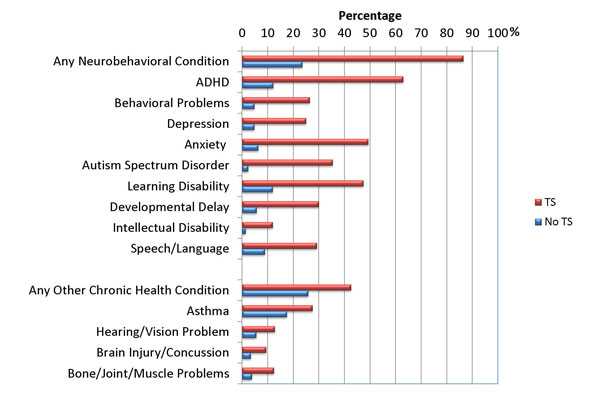Data & Statistics
* The data on this page are from the study, “A National Profile of Tourette Syndrome, 2011-2012.” unless otherwise noted. [Read article]1 [Read article on findings for 2007-08 data]2

In the United States
- We do not know exactly how many people have Tourette Syndrome (TS).
- A Centers for Disease Control and Prevention (CDC) study found that 1 of every 360 (0.3%) children 6 – 17 years of age in the United States have been diagnosed with TS based on parent report; this is about 138,000 children.
- Other studies that included children with undiagnosed TS and children with diagnosed TS have estimated that 1 of every 162 children (0.6%) have TS.
- This suggests that about half of children with TS are not diagnosed.
- Among children diagnosed with TS,
- 37% have been reported as having moderate or severe forms of the condition.
- Boys are three to five times more likely to have TS than girls. People from all racial and ethnic groups can have TS. Non-Hispanic white children are twice as likely to have a TS diagnosis as Hispanic and non-Hispanic black children.
- Children 12 – 17 years of age are twice as likely to have TS as children 6 – 11 years of age.
Co-Occurring Conditions
- Among children diagnosed with TS, 86% also have been diagnosed with at least one additional mental, behavioral, or developmental condition, such as:
- Attention-deficit/hyperactivity disorder (ADHD), 63%;
- Behavioral or conduct problems, 26%;
- Anxiety problems, 49%;
- Depression, 25%;
- Autism spectrum disorder, 35%;
- Learning disability, 47%;
- Speech or language problem, 29%
- Intellectual disability, 12%, and
- Developmental delay affecting his or her ability to learn, 28%.
- More than one-third of people with TS also have obsessive-compulsive disorder.3,4
- 42.6% have at least one co-occuring chronic health condition.
Prevalence of co-occurring conditions and disorders among children with TS
Data on 65,540 US children aged 6-17 years from the 2011-2012 National Survey of Children’s Health

Life Course
In most cases, tics decrease during adolescence and early adulthood, and sometimes disappear entirely; however, many experience tics into adulthood and, in some cases, tics can become worse in adulthood.4, 5
- One study that followed youth with TS over time found that at 18 years of age, almost half (47%) of the youth had been tic-free the week before they were interviewed, just over 10% had minimal tics, over a quarter (28%) had mild symptoms, and 11% had moderate to severe tics.2,3
Public Health Impact of TS
CDC is working to understand TS and to improve the health and wellbeing of people with TS. Learn about what public health can do to bridge the gaps in knowledge to help individuals with Tourette Syndrome.
Scientific Articles and Key Findings
A National Profile of Tourette Syndrome, 2011-2012
(Published: July 11, 2014)
Tourette Syndrome and Parenting Aggravation
Learn about how having a child with Tourette Syndrome can affect families
(Published: July 11. 2014)
Health Care Needs of Children with Tourette Syndrome
Children with TS experience greater health care needs and face challenges receiving coordinated care
(Published: July 11, 2014 )
Tourette Syndrome: Everyone Can Play a Role
Learn how everyone, including CDC, can play a role to improve the lives of people with Tourette syndrome.
(Published: June 1, 2015)
10 Years of Tourette Syndrome Education and Research
Learn about CDC’s decade of work doing research and educating the public on Tourette Syndrome.
(Published: June 2, 2014)
Tourette Syndrome: New Treatment Option
Learn about a new treatment option and find out what CDC is doing to raise awareness and educate health and education professionals about Tourette Syndrome.
(Published: June 3, 2013)
References
- Bitsko, RH, Holbrook, JR, Visser, SN, Mink, JW, Zinner, SH, Ghandour, RM, Blumberg, SJ (2014). A National Profile of Tourette Syndrome, 2011-2012. J Dev Behav Pediatr 35(5), 317-322.
- Centers for Disease Control and Prevention. Prevalence of diagnosed Tourette Syndrome in persons aged 6-17 years – United States, 2007. MMWR Morb Mortal Wkly Rep. 2009; 58(21): 581-5.
- Leckman, JF, Zhang, H, Vitale, A, Lahnin, F, Lynch, K, Bondi, C, et al. Course of tic severity in Tourette Syndrome: the first two decades. Pediatrics. 1998; 102(1 Pt 1): 14-19.
- Eapen, V, Crncec, R. Tourette Syndrome in children and adolescents: special considerations. J Psychosom Res. 2009. 67(6): 525-32.
- American Psychiatric Association. Diagnostic and statistical manual of mental disorders: Fifth edition, DSM-5, Washington, DC; 2013.
- Page last reviewed: May 11, 2017
- Page last updated: December 5, 2016
- Content source:



 ShareCompartir
ShareCompartir